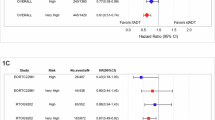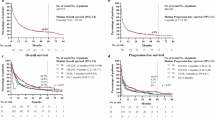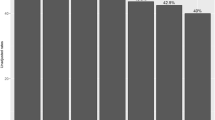Abstract
Purpose
Telomeres are essential for the maintenance of chromosomal integrity and telomere length has been associated with cancer risk and development. Aim of the present study was to analyze the prognostic value of leukocyte relative telomere (RTL) length in long-term prostate cancer (PCa) mortality.
Methods
Blood samples of PCa patients were obtained before initiation of radiotherapy. RTL of peripheral blood leukocytes was determined by a quantitative polymerase chain reaction method in 533 patients with PCa. Main outcome was overall mortality.
Results
During a median follow-up time of 149 months, 188 (35.3%) patients died. In a univariate Cox regression analysis, RTL quartiles (longer RTL) were significantly associated with higher overall mortality (hazard ration (HR) = 1.20; 95% confidence interval (CI): 1.05–1.36; p = 0.006). In a multivariate Cox regression model including age at diagnosis, androgen deprivation therapy, and risk group (based on PSA level, GS, and T stage), RTL quartiles remained a significant predictor of higher overall mortality (HR = 1.22; 95% CI: 1.07–1.39; p = 0.003).
Conclusions
Longer leukocyte RTL predicts higher overall mortality in patients with PCa.
This is a preview of subscription content, access via your institution
Access options
Subscribe to this journal
Receive 4 print issues and online access
$259.00 per year
only $64.75 per issue
Buy this article
- Purchase on SpringerLink
- Instant access to full article PDF
Prices may be subject to local taxes which are calculated during checkout

Similar content being viewed by others
References
Blackburn EH, Greider CW, Szostak JW. Telomeres and telomerase: the path from maize, tetrahymena and yeast to human cancer and aging. Nat Med. 2006;12:1133–8.
Brouilette S, Singh RK, Thompson JR, Goodall AH, Samani NJ. White cell telomere length and risk of premature myocardial infarction. Arterioscler Thromb Vasc Biol. 2003;23:842–6.
Fitzpatrick AL, et al. Leukocyte telomere length and cardiovascular disease in the cardiovascular health study. Am J Epidemiol. 2007;165:14–21.
Benetos A, et al. Short telomeres are associated with increased carotid atherosclerosis in hypertensive subjects. Hypertension. 2004;43:182–5.
Chen Y, Qu F, He X, Bao G, Liu X, Wan S, et al. Short leukocyte telomere length predicts poor prognosis and indicates altered immune functions in colorectal cancer patients. Ann Oncol. 2014;25:869–76.
Russo A, Modica F, Guarrera S, Fiorito G, Pardini B, Viberti C, et al. Shorter leukocyte telomere length is independently associated with poor survival in patients with bladder cancer. Cancer Epidemiol Biomark Prev. 2014;23:2439–46.
Weischer M, Nordestgaard BG, Cawthon RM, Freiberg JJ, Tybjærg-Hansen A, Bojesen SE. Short telomere length, cancer survival, and cancer risk in 47,102 individuals. J Natl Cancer Inst. 2013;105:459–68.
Xu X, Qu K, Pang Q, Wang Z, Zhou Y, Liu C. Association between telomere length and survival in cancer patients: a meta-analysis and review of literature. Front Med. 2016;10:191–203.
Svenson U, Nordfjall K, Stegmayr B, et al. Breast cancer survival is associated with telomere length in peripheral blood cells. Cancer Res. 2008;68:3618–23.
Svenson U, Ljungberg B, Roos G. Telomere length in peripheral blood predicts survival in clear cell renal cell carcinoma. Cancer Res. 2009;69:2896–901.
Liu HQ, An JZ, Liu J, Yang YF, Zhang HX, Zhao BY, et al. Leukocyte telomere length predicts overall survival in hepatocellular carcinoma treated with transarterial chemoembolization. Carcinogenesis. 2012;33:1040–5.
Svenson U, Oberg A, Stenling R, et al. Telomere length in peripheral leukocytes is associated with immune cell tumor infiltration and prognosis in colorectal cancer patients. Tumor Biol. 2016;37:10877–82.
Svenson U, Roos G, Wikström P. Long leukocyte telomere length in prostate cancer patients at diagnosis is associated with poor metastasis-free and cancer-specific survival. Tumour Biol. 2017;39:1–7.
Ioannidis JP. This I believe in genetics: discovery can be a nuisance, replication is science, implementation matters. Front Genet. 2013;4:33.
Langsenlehner T, Langsenlehner U, Renner W, Kapp KS, Krippl P, Hofmann G, et al. The Glu228Ala polymorphism in the ligand binding domain of death receptor 4 is associated with increased risk for prostate cancer metastases. Prostate. 2008;68:264–8.
Langsenlehner T, Renner W, Gerger A, Hofmann G, Thurner EM, Kapp KS, et al. Impact of VEGF gene polymorphisms and haplotypes on radiation-induced late toxicity in prostate cancer patients. Strahlenther Onkol. 2011;187:784–91.
Trummer O, Langsenlehner U, Krenn-Pilko S, Pieber TR, Obermayer-Pietsch B, Gerger A, et al. Vitamin D and prostate cancer prognosis: a Mendelian randomization study. World J Urol. 2016;34:607–11.
Gröber U, Holzhauer P, Kisters K, Holick MF, Adamietz IA. Nutrients. Micronutr Oncol Interv. 2016;8:163.
Reuther S, Szymczak S, Raabe A, Borgmann K, Ziegler A, Petersen C, et al. Association between SNPs in defined functional pathways and risk of early or late toxicity as well as individual radiosensitivity. Strahlenther Onkol. 2015;191:59–66.
Langsenlehner T, Thurner EM, Renner W, Gerger A, Kapp KS, Langsenlehner U. Association of genetic variants in VEGF-A with clinical recurrence in prostate cancer patients treated with definitive radiotherapy. Strahlenther Onkol. 2014;190:364–9.
Thurner EM, Krenn-Pilko S, Langsenlehner U, Renner W, Gerger A, Kapp KS, et al. Association of genetic variants in apoptosis genes FAS and FASL with radiation-induced late toxicity after prostate cancer radiotherapy. Strahlenther Onkol. 2014;190:304–9.
Langsenlehner T, Langsenlehner U, Renner W, Krippl P, Mayer R, Wascher TC, et al. Single nucleotide polymorphisms and haplotypes in the gene for vascular endothelial growth factor and risk of prostate cancer. Eur J Cancer. 2008;44:1572–6.
Langsenlehner T, Renner W, Gerger A, Hofmann G, Thurner EM, Kapp KS, et al. Association between single nucleotide polymorphisms in the gene for XRCC1 and radiation-induced late toxicity in prostate cancer patients. Radiother Oncol. 2011;98:387–93.
Mohler J, Bahnson RR, Boston B, Busby JE, D’Amico A, Eastham JA, et al. NCCN clinical practice guidelines in oncology: prostate cancer. J Natl Compr Canc Netw. 2010;8:162–200.
Cawthon RM. Telomere measurement by quantitative PCR. Nucleic Acids Res. 2002;30:e47.
Schemper M, Smith TL. A note on quantifying follow-up in studies of failure time. Control Clin Trials. 1996;17:343–6.
Gomella LG, Oliver Sartor A. The current role and limitations of surrogate endpoints in advanced prostate cancer. Urol Oncol. 2014;32:28.e1–9.
Mirabello L, Huang WY, Wong JY, Chatterjee N, Reding D, Crawford ED, et al. The association between leukocyte telomere length and cigarette smoking, dietary and physical variables, and risk of prostate cancer. Aging Cell. 2009;8:405–13.
Julin B, Shui I, Heaphy CM, Joshu CE, Meeker AK, Giovannucci E, et al. Circulating leukocyte telomere length and risk of overall and aggressive prostate cancer. Br J Cancer. 2015;112:769–76.
Svenson U, Grönlund E, Söderström I, et al. Telomere length in relation to immunological parameters in patients with renal cell carcinoma. PLoS One. 2013;8:e55543.
Author information
Authors and Affiliations
Corresponding author
Ethics declarations
Ethical standards
The study has been approved by the Ethical Committee of the Medical University of Graz and has therefore been performed in accordance with the ethical standards laid down in the 1964 Declaration of Helsinki and its later amendments. Written informed consent was obtained from all participating subjects.
Conflict of interest
The authors declare that they have no conflict of interest.
Rights and permissions
About this article
Cite this article
Renner, W., Krenn-Pilko, S., Gruber, HJ. et al. Relative telomere length and prostate cancer mortality. Prostate Cancer Prostatic Dis 21, 579–583 (2018). https://doi.org/10.1038/s41391-018-0068-3
Received:
Revised:
Accepted:
Published:
Issue date:
DOI: https://doi.org/10.1038/s41391-018-0068-3
This article is cited by
-
Telomeres, telomerase, and cancer: mechanisms, biomarkers, and therapeutics
Experimental Hematology & Oncology (2025)
-
Causal effect between telomere length and thirteen types of cancer in Asian population: a bidirectional Mendelian randomization study
Aging Clinical and Experimental Research (2025)
-
Mendelian randomization evidence based on European ancestry for the causal effects of leukocyte telomere length on prostate cancer
Human Genomics (2024)
-
The telomere length landscape of prostate cancer
Nature Communications (2021)
-
Telomere-based risk models for the early diagnosis of clinically significant prostate cancer
Prostate Cancer and Prostatic Diseases (2021)



